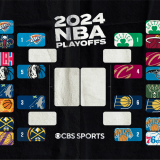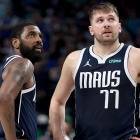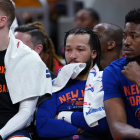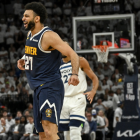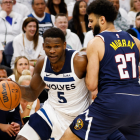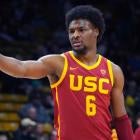Michael Jordan is adamant in the final episode of "The Last Dance." Had Chicago Bulls owner Jerry Reinsdorf and general manager Jerry Krause been willing to keep the band together, the team could have made a serious push for its seventh championship. All they needed to do, aside from keeping Phil Jackson, was offer one-year deals to Chicago's veteran free agents and they would have returned.
Krause's writings dispute this. In a diary entry published by K.C. Johnson of NBC Sports, Krause argued that the Bulls had reached the natural end of their dynasty and that their role players had grown too old and injured to continue competing. Reinsdorf concurred and mentioned another reality Jordan ignored: money. Many of Chicago's best players were free agents after the 1998 championship, and keeping all of them would have cost a fortune.
That financial reality informed Chicago's decision to rebuild. But let's say the Bulls were open to making one last run in the lockout-shortened 1998-99 season. How much would it have cost Reinsdorf to keep his team together? And would it have been worth it in the end?
Before we dive in, there is one important thing to note. The 1999 lockout shortened the season to only 50 games. This meant that players received only prorated portions of their salary. We will be using full salary numbers for this piece, all via HoopsHype's historical database, because revenue fell just as much as salary. Functionally speaking, team cap sheets didn't change even if their actual finances did. And with that, we can commence.
Who was left over?
A surprisingly large chunk of Chicago's championship roster lasted into the 1999 rebuild. In total, seven players survived the purge:
- Ron Harper, $5,280,000
- Toni Kukoc, $4,610,000
- Randy Brown, $1,320,000
- Bill Wennington, $1,000,000
- Keith Booth, $687,240
- Rusty LaRue, $350,000
- Dickey Simpkins, whose salary is unlisted, but likely the fifth-year minimum of $475,000
We also need to account for Chicago's first-round pick, Corey Benjamin, who made $540,000 in the 1998-99 season. That means we begin this exercise with eight roster spots filled at the reasonable price of around $14.3 million. Trust me, it's about to get far more expensive.
Bringing back Jordan
The 1999 CBA included the league's first-ever limitation on individual salaries. Players with at least 10 years of NBA experience would be limited in new contracts to a first-year salary of either 35 percent of the cap or $14 million, whichever was higher. Those are laughable numbers in the face of Jordan's prior salaries. Jordan had negotiated his past deals without a maximum salary in place, and took advantage of it by signing the two biggest contracts in the history of professional sports when adjusted for inflation. Jordan made $30 million for the 1996-97 season, and $33.14 million for the 1997-98 campaign. Both numbers were larger than the cap itself, which was only $26.9 million at the time of Jordan's second retirement.
Fortunately, Jordan's peers ensured that players of his caliber would not be subjected to pay cuts. A grandfather clause in the 1999 CBA allowed players whose previous salaries exceeded the max to earn up to 105 percent of their prior earnings in the first year of a new deal. That is where we'll find Jordan's salary. Multiply his 1998 salary by 105 percent and you get $34,797,000.
To put the absurdity of that contract into perspective, no NBA player earned an actual salary higher than that until the 2018-19 season. Adjust that figure for revenue inflation and it is the equivalent of a $126.5 million salary today. For a player to actually earn that much in the first year of a new deal, the cap would have to balloon to over $370 million. In the present day, it is just above $109 million and could potentially fall. No player will ever come close to Jordan's earnings in the late '90s, and in this scenario, he gets even richer.
Scottie Pippen and the free agents
With Jordan in tow, nine Chicago roster spots are now filled. That works out nicely, as the Bulls lost six fairly meaningful free agents, and reintegrating them into the roster brings us to an even 15. Five of them are fairly simple to calculate. Even though some were dealt in sign-and-trade agreements, we can assume for the sake of ease that the Bulls would have re-signed them to identical deals.
- Luc Longley signed a five-year, $30 million contract with the Phoenix Suns in a sign-and-trade. His 1998-99 cap number was $4 million.
- Steve Kerr signed a five-year, $11 million contract with the San Antonio Spurs in a sign-and-trade. His 1998-99 cap number was $1,774,000.
- Jud Buechler signed a two-year contract worth just under $2 million with the Detroit Pistons. His 1998-99 cap number was $850,000.
- Dennis Rodman signed a one-year, $1 million contract with the Los Angeles Lakers.
- Scott Burrell signed a one-year, $1 million contract with the then-New Jersey Nets.
The final free agent is a bit more complicated. Scottie Pippen left the Bulls to seek out long-term financial security, yes, but by the time he did, there was so much bad blood between him and the organization that reconciliation may not have even been possible. He demanded trades on multiple occasions due to the bitterness that arose out of the comically horrendous contract he signed in 1991. In reality, he signed a hefty five-year, $67 million contract with the Houston Rockets in the offseason that included another $15 million in incentives. The Bulls even helped facilitate that deal by structuring it as a sign-and-trade to help Pippen make some extra money. But there is no telling whether or not he would be willing to return to the Bulls even at that figure. Pippen needed respect.
So, in the interest of giving it to him, we are going to bump his salary up to the max. In reality, he earned $11 million for the 1998-99 season. In this scenario, that jumps to $14 million. We'll maintain the five-year structure of the deal and include the biggest annual raises Chicago could give him at 12.5 percent. That turns this into a guaranteed five-year, $87.5 million pact. While Krause likely would have loathed paying Pippen this much, it's not as though he was untradable. The Rockets dealt Pippen to the Portland Trail Blazers at a slightly lower price only one year into his actual deal, so this shouldn't preclude Krause from flipping him when he's ready to hit the reset button.
So where does that leave us? In a neighborhood none of us can afford. Below is our projected cap sheet:
| Player | 1998-99 Salary |
|---|---|
Michael Jordan | $34,797,000 |
Scottie Pippen | $14,000,000 |
Ron Harper | $5,280,000 |
Toni Kukoc | $4,610,000 |
Luc Longley | $4,000,000 |
Steve Kerr | $1,774,000 |
Randy Brown | $1,320,000 |
Dennis Rodman | $1,000,000 |
Scott Burrell | $1,000,000 |
Bill Wennington | $1,000,000 |
Jud Buechler | $850,000 |
Keith Booth | $687,240 |
Corey Benjamin | $540,000 |
Dickey Simpkins | $475,000 |
Rusty LaRue | $350,000 |
Total: | $71,683,240 |
So here we have the realistic cost of bringing back the Bulls at around $71.7 million. There's some wiggle room in either direction. Perhaps Pippen comes back for a bit less than the max. Perhaps Rodman gets a bit more than his minimum considering the Bulls have his Bird Rights. Generally speaking, though, before we consider cost-of-doing-business matters like 10-day contracts and potential trades, we're looking at a payroll in the $70 million range.
Already, that leaves the Bulls with the NBA's most expensive roster by a wide margin. The Knicks earned that honor in reality with a $59.9 million payroll, and the 1997-98 Bulls held the previous record at $61.3 million. Topping that figure by a full $10 million is substantial, and we aren't even done yet.
Adjusting for one-year deals
Reinsdorf and Krause had no interest in keeping this roster around for the long haul, and nor should they have. Jordan was 35. Pippen was 33. Virtually every role player of note was in his 30s. The Bulls might have been willing to pay up to keep the team together, but they weren't giving role players long-term deals. Multi-year deals for Longley, Kerr and Buechler are off the table. If they're coming back, it would have to be on one-year pacts, and Jordan even acknowledged that in "The Last Dance".
The question then becomes how much their salaries need to be adjusted. All three would need substantial raises to pass up the security of long-term deals, but without knowing what offers real-life free-agents have rejected, there is no set formula for weighing lump sum single-year contracts against their multi-year counterparts. The few comparisons we can make are daunting for Chicago.
JJ Redick is a notable recent example of a player known to have made such a choice. He has spoken publicly about his 2017 free agency in which he needed to decide between the Houston Rockets' four-year mid-level offer of $32 million or the Philadelphia 76ers' one-year lump sum of $23 million. Houston made the choice for him when it took that fourth year off the table, but if we assume that he viewed the two offers roughly equally at the time, we see that a 287.5 percent salary increase was the tax Philadelphia was paying on Redick's market value in order to get him for a single year.
A more modest counter would be 150 percent. That is the one-year total it took Marcus Morris to renege on his two-year, $20 million deal with the Spurs to take one year and $15 million from the Knicks. It should be noted, though, that he had much less to lose. He gave up a two-year offer, not a four-year contract. Again, there is no exact formula here. The middle ground in these cases is 218.75 percent. It's an imperfect solution, but we'll settle slightly below that at 215 percent. In the interest of limiting costs further, we'll base that total off their 1999 salary, not the average of their original contract.
Considering the situation each of Chicago's free agents found themselves in, it's not a stretch to suggest that they would have demanded such treatment. Longley had ankle issues. In reality, injuries and age-related decline had already begun to set in by his first season in Phoenix, so he likely sought out long-term money knowing that he soon wouldn't have the leverage to do so. Kerr was in a similar boat. After posting unheard of shooting numbers with the NBA's shortened 3-point line from 1994 through 1997, his percentages declined in 1998 and fell off a cliff in 1999. He, too, had reason to seek out long-term security. With these adjustments in mind, here's where our free agents fall:
- Longley jumps from $4 million to $8.6 million. This seems like the right range considering the more skilled but similarly injured and aging Arvydas Sabonis made $9 million this season.
- Kerr jumps from $1,774,000 to $3,814,100. Unlike Longley's deal, this seems a bit extravagant given market conditions. Fellow aging marksmen Dell Curry and Terry Porter made only $1 million each in 1999. However, Kerr's clutch credentials theoretically could have inflated his value. Contenders routinely overpay their own free agents as well.
- Buechler jumps from $850,000 to $1,827,500. Probably a bit much, but Buechler played well for the Pistons in reality.
So now we have our salaries across the board. When you factor in the raises to Longley, Kerr and Buechler, the Bulls' total salary rises to $79,345,840
What does that number mean in context?
For starters, it's the most expensive roster in NBA history. That doesn't mean much in itself. It only took the Portland Trail Blazers two years to zoom past them with an $87.4 million payroll for the 2000-01 season, and they topped the $100 million barrier two years later at $105.6 million. However, when expressed as a percentage of the cap, neither team tops the adjusted-for-inflation Bulls:
| Team | Salary | Cap | Percentage of cap |
|---|---|---|---|
Hypothetical 1998-99 Bulls | $79,345,840 | $30,000,000 | 264.5 percent |
2000-01 Trail Blazers | $87,395,140 | $35,500,000 | 246.2 percent |
2002-03 Trail Blazers | $105,595,657 | $40,271,000 | 262.2 percent |
Once something resembling the modern luxury tax was implemented in 2005, teams stopped dwarfing the cap by such preposterous numbers. Therefore, we can safely call this hypothetical Bulls team the most expensive roster in NBA history relative to the revenue being generated at the time. It's also worth pointing out that those Blazers are hardly a fair barometer. They were owned by Paul Allen, the richest owner in sports at the time. He died with a $20 billion net worth, and was happy to absorb financial losses for the sake of wins on the court in a way that most owners could not afford. By typical owner standards, Reinsdorf is practically lapping the field.
This is the portion of the exercise that is purely academic. The current cap is $109,140,000. Therefore, if we multiply that by 264.5 percent, we get a modern salary of $288,675,300. That's right, if Reinsdorf had kept the Bulls together using modern figures, he would have nearly had a $300 million roster ... before factoring in a potential luxury tax.
The highest payroll in NBA history based solely on salary figures would be the 2018-19 Golden State Warriors at around $146.3 million. Even with their $51.5 million luxury tax payment and a slight inflation bump thanks to this year's higher cap, the Warriors would still fall around $100 million short of our hypothetical Bulls.
Calculating a potential luxury tax payment for the modern version of these Bulls would be pointless. The NBA's luxury tax rates are not capped, increasing with every $5 million increment above the tax line a team spends. The real tax line is $132,670,000. Our Bulls are over $156 million above that. When you factor in the infinitely increasing rates, a modern team spending $288 million on salary would literally have to pay billions of dollars in luxury taxes. The system is no longer designed to allow teams to spend three times the cap. The tax was built specifically to combat that.
Even without a tax and even under the more modest raw figures of the late 1990s, the Bulls would have had an obscenely expensive roster. That begs another important question ...
Would it have been worth it?
Jordan seemed very confident in the final episode of "The Last Dance" that his Bulls would have won their seventh championship if Reinsdorf had simply put up the money to do so. But let's look at what actually became of these Bulls players in 1999.
- Pippen missed out on an All-Star selection despite being healthy for the first time since 1991, and averaged only 14.5 points per game for Houston.
- Longley's scoring, rebounding, assist and block numbers all declined in Phoenix as he proved unable to handle a starter's workload at 30 years old. He averaged only 23.9 minutes per game that season, and played only 97 total games after it.
- Kerr shot 31.3 percent from behind the arc in his first season in San Antonio and averaged only 4.4 points per game. That was his highest total for the rest of his career.
- Rodman played only 23 games for the Lakers before being released. His career closed after only 12 more games in Dallas.
- Harper, Wennington and Buechler all retired by 2002.
The Bulls were very clearly a team in decline by the 1998 NBA Finals. Had Jordan missed his legendary shot over Bryon Russell, Chicago likely would have had to have played Game 7 without Pippen. Jordan didn't have another level to rise to. He took more than half of Chicago's shots in Game 6, and even that was only enough to lift the Bulls to a one-point victory.
It may be hard for Jordan or his most ardent fans to hear, but barring other moves, the Bulls probably weren't going to win a seventh championship in 1999. They were too old, too injured and too worn down from their three previous championship runs. Asking Reinsdorf to fund the most expensive roster in history when he was likely aware of all of this would have been unrealistic. As vilified as he and Krause are to this day, breaking up the Bulls at that point was, in all likelihood, the correct decision.








